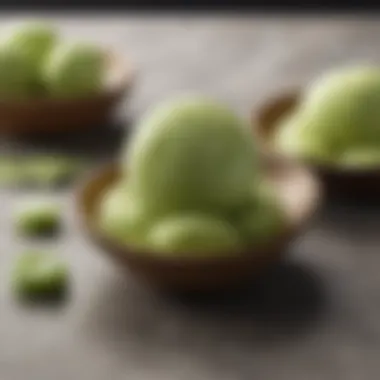Exciting and Unique Ice Cream Flavor Inspirations


Intro
Ice cream has always been a beloved treat, but the world of ice cream flavors often stays within the safe boundaries of chocolate or vanilla. Luckily, there’s a fascinating spectrum waiting to be discovered beyond these familiar shores. You'll find an evolving landscape where innovation meets tradition, and flavors have become a canvas for creativity.
In this exploration, we dive into the unexpected, mixing savory and sweet, traditional and contemporary, grounded in cultural influences and innovative techniques. This guide aims to inspire both home cooks and professional gelato makers to think outside the box and experiment with flavors that dance on the palate.
Imagine a world where rosemary-infused olive oil dances with sea salt caramel, or where the earthiness of roasted beetroot contrasts beautifully with the sweetness of chocolate. Each flavor combination tells a story, often influenced by cultural ingredients that are become commonplace in gourmet kitchens today. With careful attention to both texture and flavor balancing, it’s possible to create ice creams that aren't just desserts but memorable experiences.
Let’s embark on this journey and uncover innovative recipes designed to whet your appetite for new and exciting flavors, offering ideas from the savory side of the spectrum to adventurous twists on our childhood classics.
Prepare to expand your culinary repertoire as we look into a myriad of flavor profiles and the techniques for achieving that perfect scoop.
"Great ice cream is not just about the taste; it's about the emotions it evokes. It should transport you, surprise you, and make you want more."
With this in mind, let's start with a comprehensive overview of some innovative ice cream recipes that will inevitably challenge your palate and ignite your passion for homemade frozen delights.
Exploring Unconventional Flavors
Ice cream, while primarily associated with sweet and creamy flavors, has opened itself to a vast world of unconventional ideas. Exploring these innovative flavors brings a significant depth to the ice cream experience, attracting connoisseurs and curious food enthusiasts alike. The allure of unexpected tastes can elevate a simple scoop into something truly remarkable. By venturing into savory realms or fusing cultures, ice cream makers can capture a mosaic of flavors that tickle the palate and spark joy in each bite. Not only does this experimentation cater to adventurous eaters, but it also offers a fresh perspective on how flavors can harmonize in delightful ways.
Pairing herbaceous notes with creamy bases or infusing traditional compositions with international flair excites the senses, challenging our standard expectations of what ice cream should be. Fact of the matter is that these unconventional flavors often reflect seasonal changes, local ingredients, and even cultural narratives, thus enriching the entire experience.
The Allure of Savory Ice Creams
The world of savory ice creams presents an intriguing frontier. Incorporating elements usually found in main dishes introduces a burst of creativity. People can find herb-infused choices, cheese-inspired flavors, and combinations of vegetables and fruits that pleasantly surprise.
Herb-infused Options
Herb-infused ice creams represent a compelling intersection between sweet and savory. By incorporating herbs like rosemary or basil, these creations offer more than just sweetness; they impart a refreshing and unique profile. This eclectic combination can couple with rich desserts, complementing ingredients like strawberries or dark chocolate in ways most don't expect. Misconceptions about dessert flavors are shattered as the cooling element of ice cream marries beautifully with herbal notes. The difficulty lies in finding the right balance, as introducing strong herbaceous flavors could overpower the delicate nuances of the base. Yet, when done right, the innovation yields an invigorating treat that prompts further culinary exploration.
Cheese-Flavored Innovations
Cheese-flavored innovations delve into an extraordinary territory by turning a traditional dairy item into a delightful dessert. Think of creamy mascarpone or tangy blue cheese swirling harmoniously within ice cream. The inherent rich, savory flavor of cheese provides a welcome contrast to the sweetness of typical ice cream. This gives rise to desserts that feel luxurious and sophisticated. A key characteristic is the creamy texture which complements the sweetness, all while maintaining a flair that is striking yet comforting. However, the challenge remains in appealing to a broader audience, as not everyone is ready to embrace cheese as a dessert component.
Vegetable and Fruit Harmonies
Vegetable and fruit harmonies allow for some bold flavor experimentation. By mixing earthy vegetables with fruits, an unexpected marriage blooms. A pureed blend of carrots with orange can create a vibrant ice cream that is both refreshing and nutritious. This approach not only introduces healthy options but also reduces the need for excessive sweeteners. However, the challenge lies in achieving the right texture and consistency since vegetables can sometimes lead to a grainy feel if not prepared properly. Yet, the right pairing can craft a sophisticated ice cream that pleasantly surprises food lovers.
International Inspirations
When exploring ice cream flavors, the influence of global culinary practices is undeniable. Different cultures offer a treasure trove of flavors that can be seamlessly integrated into this classic treat. From the spicy notes of Asian cuisine to sweet European traditions and vibrant Latin American tastes, international inspirations enhance the ice cream landscape.
Asian Infusions
Asian infusions in ice creams introduce a myriad of bold flavors, such as matcha, ginger, or lychee. The significance of these flavors lies in their deep-rooted cultural history. Matcha, for instance, is not merely a flavor; it's a nod to centuries-old traditions and its health benefits. This characteristic draws in health-conscious consumers looking for elements beyond traditional ingredients. On the flip side, the challenge often comes in capturing the essence of these flavors without going overboard, ensuring that they complement rather than dominate the ice cream base.
European Classics
European classics incorporate well-known flavors like tiramisu or panna cotta into ice cream. The beauty of these flavors lies in their familiarity, making them approachable yet still innovative. These traditional tastes can entice nostalgic feelings while inspiring culinary curiosity. One of the unique features is their adaptability; you might find tiramisu ice cream swirled with espresso or whipped cream, perfectly echoing the original dessert. However, relying too heavily on these classics may risk falling back into the realm of the predictable.
Latin American Flavors
Latin American flavors are characterized by vibrant ingredients that are often mixed into ice cream, such as dulce de leche or fresh mango. These rich flavor profiles provide depth and a touch of sweetness that lingers. The appeal lies in their embrace of fruits and other ingredients that evoke a sunny disposition. Additionally, these flavors resonate well with audiences seeking authentic experiences. However, one must consider that the complexity of flavors may not translate easily for everyone, as some might find the intensity overwhelming.
"Innovation in ice cream is not just about being different; it’s about crafting experiences through flavors that tell a story, bridging cultures and histories together in a scoop."
The exploration of unconventional flavors is a dynamic journey that pushes boundaries and invites both creativity and enjoyment, making it a fascinating subject worthy of in-depth appreciation.
Traditional Flavors with a Twist
Traditional flavors are the backbone of the ice cream world, but adding a twist can breathe new life into familiar favorites. This section emphasizes the importance of reinventing classic tastes so they resonate with evolving palates. Traditional flavors hold nostalgia and comfort, yet blending them with innovation allows both chefs and home cooks to experiment freely. The result? Exciting desserts that delight the senses while sparking curiosity.
Chocolate Variations
Spicy Chocolate
Spicy chocolate ice cream is not just a trend; it’s a sensory adventure waiting to unfold. The introduction of spices such as cayenne or chili provides a distinct contrast to the intrinsic sweetness of chocolate. This combination heightens flavor complexity and engages the taste buds on multiple levels. It has become an attractive choice for those who enjoy a little heat with their desserts.
- Key Characteristic: The warm kick from the spice-sweet harmony.
- Benefits: Perfect for adventurous eaters; sparking buzz among fans of fusion flavors.
- Unique Feature: Spicy chocolate can create a delightful tingle on the palate, making it memorable. While it broadens the dessert horizon, one must be cautious with the spice level to avoid overwhelming the core chocolate flavor.
Chocolate with Sea Salt
The marriage of chocolate and sea salt is a timeless classic, yet its impact on ice cream deserves special mention. It's not merely about taste; it's about the perfect balance that enhances richness. The salt amplifies the chocolate's sweetness, creating a dynamic flavor that elevates the entire experience.
- Key Characteristic: Salty-sweet contrast that surprises the palate.
- Benefits: Universally appealing for chocolate lovers; great as a sophisticated scoop for adults.
- Unique Feature: The flakes of sea salt provide a crunchy bite that feels luxurious. However, one must avoid overdoing it, as too much salt can overshadow the chocolate itself.
Chocolate-Covered Fruits
This flavor is more than an ice cream; it's a treat that blends the juicy texture of fresh fruits with rich chocolate enveloping them. It captures that delightful childhood memory of dipped bananas or strawberries. The fusion of creaminess from the ice cream with the juicy freshness of fruit is simply irresistible.
- Key Characteristic: A versatile flavor that can combine varied fruits, such as strawberries and blueberries.
- Benefits: Appeals to those who seek healthier indulgences; flavors can be customized based on available fruits.
- Unique Feature: The freshness of fruits enhances the ice cream experience—offering a summertime vibe year-round. Yet, the challenge lies in balancing the chocolate coating; too thin and it’s non-existent, too thick and it overwhelms the fruit.
Reimagined Vanilla
Vanilla with Infused Spirits


Infusing vanilla ice cream with spirits like rum or bourbon marries traditional flavor with adult sophistication. The subtle complexity introduced by the alcohol can elevate the overall ice cream experience, adding depth that standard flavors might lack.
- Key Characteristic: The warming touch of spirit elevating vanilla’s natural essence.
- Benefits: Opens doors for more mature flavor profiles, perfect for specialty events or gatherings.
- Unique Feature: The alcohol evaporates during churning, leaving rich flavors without excessive booziness. However, it’s vital to be cautious with alcohol content to maintain texture.
Floral Vanilla Combinations
This flavor iteration involves blending vanilla with delicate floral notes such as lavender or jasmine, creating an ice cream flavor that is as aromatic as it is tasty. The floral element adds an unexpected freshness that pairs well with vanilla's creaminess.
- Key Characteristic: Subtle floral notes that create a fragrant ice cream experience.
- Benefits: Appeals to those seeking unique and sophisticated desserts; it's a hit at high-end restaurants and tea houses.
- Unique Feature: Balancing floral flavors with vanilla is an art; too much can overpower, while too little drifts into the background.
Vanilla Bean vs. Extract
When it comes to vanilla, using vanilla bean pods over extract is a decision that can significantly impact flavor profile and texture. The role of these pods adds visual appeal while providing robust flavor, making them a superior choice in ice cream concoctions.
- Key Characteristic: The presence of flecks from vanilla beans adds charm and authenticity.
- Benefits: Elevates the quality of ice cream; many discerning consumers recognize and appreciate the difference.
- Unique Feature: The distinct specks serve as an indicator of quality, inviting conversations around gourmet choices. The downside is that vanilla beans can be significantly more expensive than extract, which may deter some cost-conscious makers.
Innovative Pairings
Incorporating creative pairings in ice cream flavors is essential for crafting unforgettable culinary experiences. Combining unexpected ingredients can lead to intriguing contrasts that engage the senses, pushing the boundaries of traditional flavor profiles. These innovative pairings not only delight adventurous eaters but also serve as conversation starters, giving food enthusiasts a chance to share thoughts on unique tastes. Furthermore, the right pairing can accentuate textures and enhance the overall enjoyment, making each scoop an adventure of its own.
Unexpected Combinations
Maple Bacon Swirl
Maple Bacon Swirl is a delightful fusion that marries the sweetness of maple syrup with the savory notes of crispy bacon. This combination is particularly compelling as it evokes comforting breakfast memories while simultaneously breaking the norm in a dessert context. The key characteristic of Maple Bacon Swirl lies in its ability to bridge sweet and savory worlds; it has found favor among those looking for an ice cream that surprises.
One unique feature of Maple Bacon Swirl is the texture contrast—the creamy ice cream smoothness against the crunchy bacon bits. This aspect can invite various connoisseurs to enjoy something new and different. However, making this ice cream isn't without its challenges. The sweet and salty balance has to hit just right; too much sweetness can overshadow the bacon's richness and vice versa. Still, its popularity continues to soar in artisan ice cream shops.
Thai Chili Mango
Thai Chili Mango is an exciting tropical-inspired flavor that brings a lively kick to the traditional sweetness of mango. This pairing captures the essence of Thai cuisine, where the hot and sweet flavors coexist harmoniously. The balancing act of the fiery chili heat and the refreshing mango creates an exhilarating tasting experience.
The standout feature of Thai Chili Mango is its ability to evoke memories of summer markets bursting with ripe fruits and spicy dishes. It’s a popular choice for adventurous eaters seeking that rush of bold flavors in a frozen form. On the downside, this flavor can be polarizing—those who prefer mild or conventional tastes might shy away from it. Nevertheless, it remains a must-try for anyone wanting a rush of excitement in their dessert.
Olive Oil and Sea Salt
Olive Oil and Sea Salt is a sophisticated flavor that has made waves in the gourmet ice cream sector. This rich and creamy option showcases a silky texture, with the olive oil adding a layer of depth and complexity to what many might expect from ice cream. The sea salt pulls together sweetness, creating an exquisite balance that lingers on the palate.
The unique selling point of this pairing is its culinary elegance. Olive Oil and Sea Salt ice cream isn’t just a treat; it’s a gastronomic experience that invites discussions about quality ingredients and artisanal techniques. While it is a carve-out for culinary enthusiasts, its earthy richness may not resonate with everyone’s sweet tooth—making it a niche but impactful choice in the ice cream landscape.
Nostalgic Flavors Revisited
S'mores Reimagined
S'mores Reimagined takes the classic campfire treat and transforms it into a rich, indulgent ice cream flavor. The inviting combination of graham cracker crumbles, gooey marshmallow, and swirls of rich chocolate creates a nostalgic experience that many find comforting. Its charm lies in its ability to evoke childhood memories while appealing to a modern palate.
This ice cream flavor's unique aspect is the pitch-perfect interplay of crunch and creaminess—each scoop delivers a little crunch followed by a soft melt. However, it may fall short for those looking for lighter dessert options, as it tends to be more indulgent and rich than other ice creams.
Childhood Cereal Concoctions
Childhood Cereal Concoctions is a playful nod to the joys of breakfast growing up. This ice cream flavor combines bits of your favorite cereals with creamy ice cream, creating a fun and whimsical flavor palette. The key characteristic here is its nostalgic appeal, reminding people of carefree mornings spent over a bowl of cereal.
One unique feature of this flavor is the versatility it offers—the variations are infinite, from fruity loops to cocoa puffs, allowing for a smorgasbord of choices. However, while the flavor can evoke sweet memories, it might not be suitable for those seeking more sophisticated dessert profiles, as it tends to lean a bit whimsical.
Homemade Cookie Dough
Homemade Cookie Dough ice cream takes the classic edible cookie dough and reimagines it into a creamy confection. It truly captures the heart of cookie lovers everywhere. The unique aspect of this pairing is the dollops of rich cookie dough combined with the ice cream base, fostering a delightful texture that keeps tasters coming back for more.
Its undeniable advantage is in its familiarity, making it a comforting choice for many. Yet, one consideration to have in mind is the health aspect; the indulgence comes with added calories, which may deter health-conscious consumers—a trade-off that ice cream lovers typically find worthwhile.
Incorporating Regional Ingredients
Incorporating regional ingredients into ice cream flavors not only honors local cultures and traditions but also enhances the overall taste experience. This practice invites creativity by encouraging ice cream makers to tap into the unique agricultural offerings of their area. When locally sourced components are used, they often bring vibrant flavors, freshness, and an authenticity that isn’t easily replicated with mass-produced ingredients. Plus, this approach supports local farmers and producers, fostering sustainability.
As consumers increasingly seek transparency in food production, ice cream artisans are rising to meet the challenge by emphasizing the importance of using regional, seasonal, and specialty ingredients. It’s about telling a story through flavor—a narrative that connects consumers with their food and the people who produce it.
Seasonal Produce Applications
Berry Flavors Variants
Berries represent a spray of color and flavor, offering a palette that ice cream makers can play with seamlessly. Strawberries, blueberries, raspberries, or blackberries can turn a simple ice cream base into a delightful seasonal treat. The key characteristic of berry flavors lies in their natural sweetness and acidity, which provide a vibrant contrast, enhancing the creamy texture of ice cream. They are a popular choice due to their wide availability and versatility, making them perfect for creating sorbets, swirls, or even as a chunky mix-in.
One unique feature of berry flavors is their ability to pair well with other ingredients, such as vanilla or even herbal notes like basil. However, balancing the sweetness with the inherent tartness of some berries may require attention. This makes berry flavors both an advantage and a source of complexity in ice cream crafting.
Citrus Sensations
Citrus fruits are another exciting addition to the world of ice cream flavors. Zesty and refreshing, adding lemon, lime, or even blood orange can inject a bright, invigorating punch into traditional formats. These flavors dominate with their boldness, making them a standout favorite among adventurous eaters.
The unique feature of citrus sensations is their aroma and freshness, which contributes to a sensation of lightness. This is particularly beneficial in hot weather when consumers might look for something refreshing. Still, it warrants caution, for too much citrus can easily overshadow the delicate creaminess of the ice cream base, rendering it unbalanced.
Autumnal Spice Blends
As the leaves change, so do the flavors that appeal to our senses. Autumnal spice blends like cinnamon, nutmeg, and ginger not only evoke nostalgia but also bring warmth to the palate. Pumpkin spice, for example, has become a hallmark of fall flavors—transforming ice cream into a cozy treat reminiscent of seasonal festivities.
These blends allow for creativity in developing unique twists on classic favorites. The ability to create myriad variations with both spice level and sweetness makes autumnal blends advantageous in drawing flavor enthusiasts. However, achieving harmony between spices and the ice cream base can take some finesse, ensuring that no single note becomes too overwhelming.


Locally Sourced Specialty Ingredients
Artisan Honey Swirls
Artisan honey offers a natural sweetness with distinct flavor profiles depending on its floral source. This allows artisan ice cream makers to infuse their treats with rich and nuanced flavor, showcasing local honey varieties—be it wildflower, clover, or even sage.
The key characteristic of artisan honey swirls is their unique and potent flavor, which can elevate simple ice cream to a gourmet experience. They are viewed as both beneficial for their natural sweetness and for the health aspects often associated with raw honey. The primary downside may be the cost, which can rise significantly depending on sourcing and production practices.
Craft Beer Infusions
Craft beer infusions in ice cream present a bold and unexpected twist, merging brewing culture with culinary creativity. Flavors like stout fudge or hoppy grapefruit sorbet cater to craft beer enthusiasts, providing unique collaborations between ice cream makers and breweries.
The standout feature of craft beer is its wide range of flavors—from bitter hops to rich malt. This variety gives ice cream makers vast opportunities for experimentation. However, balancing the carbonation and bitterness with the sweetness of the cream can be tricky, as these attributes may clash rather than harmonize without careful consideration.
Nuts and Seeds Contributions
Nuts and seeds add both crunch and nutrition to ice creams. Varieties such as almonds, pistachios, or sunflower seeds can either be ground into butter, folded in as mix-ins, or used as toppings. Each type contributes different textures and flavors—from the earthiness of pecans to the rich creaminess of macadamia nuts.
The advantage of including nuts and seeds lies in their nutritional profile, often rich in healthy fats and protein, making ice cream a more balanced indulgence. However, for those with allergies, the risk of cross-contamination becomes a significant concern, necessitating caution and clear labeling in artisanal practices.
Incorporating these regional ingredients not only creates unique flavors but also connects the ice cream experience to the roots of its community.
This dual approach of celebrating locality while enhancing flavor makes the process of crafting ice cream a rich and fulfilling endeavor.
Texture Considerations
Texture is often the unsung hero of any ice cream experience. While flavor captures attention, texture shapes the entire tasting journey, influencing how those flavors are perceived and enjoyed. Creaminess, crunchiness, and the overall consistency play pivotal roles in defining the experience of each scoop. When it comes to ice cream, the right texture can elevate a simple dessert into a memorable treat, making the understanding of these elements vital for both home cooks and professional ice cream artisans alike.
Creaminess and Consistency
Cream Ratios and Dairy Alternatives
One of the first things to consider in crafting ice cream is the cream ratio. A higher cream content generally results in a richer, more luxurious mouthfeel. But when it comes to dairy alternatives, achieving that creamy texture can be trickier. Many brands use coconut milk, almond milk, or oat milk, each bringing its own unique characteristics. For instance, coconut milk can add a tropical hint while offering creamy goodness. However, it's important to note that dairy alternatives often have less fat than traditional cream. This can lead to a somewhat icier texture unless specific emulsifiers or stabilizers are used.
Using just the right cream ratio is crucial, and experimenting with different dairy types allows creators to tailor the experience.
Implementing Air Incorporation Techniques
Incorporating air into ice cream might sound straightforward, but it's a delicate art. The method used to churn the mixture affects how much air is introduced into the ice cream, which in turn greatly impacts its texture. The fluffier the ice cream, the smoother the melt-in-your-mouth sensation. Techniques like using a high-quality ice cream machine can enhance the creaminess significantly. However, too much air can be detrimental, leading to a light, airy texture that might sacrifice flavor depth.
The goal here is a balance; just enough air should be incorporated to give that delightful lightness without losing the satisfying richness.
Freezing Process Impacts
Freezing is the final act in ice cream creation, but it’s not just about lowering the temperature. The speed at which ice cream freezes can influence the size of the ice crystals that form. Slower freezing results in larger crystals, which can lead to a grainy texture. On the other hand, quickly freezing the ice cream creates smaller ice crystals, giving a smoother result.
Thus, finding an ideal freezing technique is essential. Factors such as the temperature of the freezer and the initial temperature of the ice cream base play crucial roles. Ice cream makers must ensure that their creations are frozen at optimal conditions to achieve that perfect creamy texture.
Incorporating Crunchy Elements
Crushed Cookies and Candies
Adding crushed cookies or candies is an easy way to introduce delightful contrast in texture. They provide that satisfying crunch while complementing the creaminess of the ice cream. Think of classic options like crushed Oreos that not only infuse flavor but add a fun texture that entices the palate. However, a common pitfall is moisture; if busy add ins are not properly mixed in or if the base melts too much before refreezing, it can lead to a soggy mess. Therefore, balancing the ratio between cookie-candy crunch and the creamy texture is pivotal.
Nut Varieties
Nuts, both whole and crushed, offer a wealth of texture and flavor diversity. Almonds, pecans, and walnuts all bring unique oils and flavors to the table, improving not just the texture but also adding a heartiness. However, considering allergies and dietary preferences is crucial, ensuring that nut-free options are identified. The richness of nuts can enhance creaminess, but they can also overwhelm the ice cream if not balanced properly. All in all, nuts serve as an elegant addition when used judiciously.
Gourmet Toppings Options
Gourmet toppings can take ice cream to the next level, providing finishing touches that excite the senses. Think artisanal chocolate shavings, sprinkled sea salt, or even edible flowers. These enhancements enrich not only the visual appeal but also the flavor profile. The key is to choose toppings that complement the base flavor; a rich chocolate base could be balanced out with light, crunchy toppings to avoid clashing. Yet, care must be taken—the wrong choices could dilute the overall eating experience, making gourmet toppings an art in themselves.
Presentation Techniques
When it comes to ice cream, even the most innovative flavors can be made to pop with the right presentation techniques. The visuals contribute significantly to the dining experience, appealing not only to the palate but also to the eye. A beautifully presented dessert will undoubtedly increase anticipation and satisfaction, proving that we eat with our eyes first. Understanding presentation styles not only enhances the overall aesthetic but also can elevate the entire consumption experience.
Serving Styles
Classic Scoops vs. Soft Serve
Classic scoops of ice cream bring a certain nostalgia and tradition that many find comforting. Each scoop neatly rounded showcases the rich, creamy texture, allowing the vibrant colors of the flavors to shine. This method is popular because it epitomizes the traditional ice cream experience, often evoking fond childhood memories.
On the other hand, soft serve offers a light and airy alternative. The unique trait of soft serve is its creamy, almost cloud-like texture that seems to melt into the mouth. This style is often associated with fun summer outings, making it a crowd-pleaser at fairs and festivals. One should consider, however, that while soft serve is delightful and offers a variety of swirl toppings, it can sometimes stray from the rich indulgence an artisan ice cream enthusiast may seek.
Layered Parfaits
Layered parfaits represent a indulgent yet creative way to showcase ice cream. They combine various textures and flavors, creating a feast for both the eyes and taste buds. The key characteristic here is the visual layers—each layer revealing a different ingredient, be it a rich chocolate fudge, fresh seasonal fruits, or crunchy granola.
Parfaits encourage exploration; with every spoonful, you get a journey through flavors and textures. Moreover, they’re often seen as healthier options, particularly when loaded with fresh fruits and nuts. However, careful construction is vital to avoid mushiness, as all layers should harmonize without overpowering one another.
Elegant Floating Desserts
Elegant floating desserts are a stunning way to present ice cream. These concoctions are about creating a sense of levity, with the ice cream appearing to float atop a flavorful base—think creams, liqueurs, or even coffee. They not only look exquisite but also provide a sensory experience as the eater mixes the components themselves.
The allure of this style lies in its sophistication. Typically presented in clear dishes to highlight the beauty of the components, floating desserts can make any occasion feel special. However, it’s important to remember that they require more intricate preparation and, depending on the base used, can potentially overshadow the ice cream itself.


Garnishing for Impact
Edible Flowers
Edible flowers have gained popularity in recent years, adding a touch of elegance and whimsy to ice cream presentations. Their vibrant colors enhance the visual appeal while offering subtle flavors that can elevate the overall experience. For instance, the delicate taste of lavender pairs beautifully with vanilla ice cream, creating a serene escape.
Utilizing edible flowers is not just about appearance; they also introduce an element of nature and authenticity to the dish. However, one must ensure that the flowers used are indeed edible and free from pesticides.
Drizzles and Syrups
Drizzles and syrups provide a way to personalize each scoop. They contribute both flavor and texture, with options ranging from decadent chocolate fudge to bright berry coulis. This method enhances the overall taste while encouraging creativity and customization.
The beauty of drizzles is the variety they bring. You can experiment with homemade fruit syrups to offer a taste of nostalgia or opt for gourmet chocolate sauces for richness. A downside is that too much syrup can overwhelm the ice cream, so balance is key for a delightful experience.
Culinary Herbs Utilization
Incorporating culinary herbs into ice cream garnishes is an unexpectedly delightful twist. Fresh basil, mint, or even rosemary can add a fragrant edge to your dessert. The unique aspect of this choice lies in its ability to transform standard flavors into something astonishingly complex. Consider a mint garnished on top of a chocolate scoop—suddenly, it’s refreshing rather than mere sweetness.
One must be cautious with herb choices, as the wrong combination can yield a less-than-desirable taste. However, done right, herbs can elevate ice cream into a gourmet realm, enticing those adventurous enough to explore their full flavor potential.
Health-Conscious Variations
Ice cream is no longer simply a dessert; it's evolved into a canvas for culinary creativity, especially for those aiming to watch their waistlines or seek healthier options. The increasing demand for indulgence without guilt is steering the industry towards health-conscious variations. These variations not only cater to the health-savvy demographic but also introduce flavors and ingredients that are both exciting and comforting. The blend of nourishment and flavor isn't just a trend; it represents a shift in consumer expectations on what ice cream can be.
Low-Calorie Alternatives
Frozen Yogurt Options
Frozen yogurt has gained quite a following over the past decade, largely due to its perception as a healthier ice cream alternative. Key characteristics of frozen yogurt include lower fat content compared to traditional ice cream, owing to the use of yogurt as a base. It's often tart, which can be an appealing contrast to the sweetness found in standard ice cream.
This option is popular for its versatility; it can be adorned with toppings ranging from fresh fruits to granola, which only enhances its appeal. However, a unique feature is that it sometimes contains added sugars, which can nullify its health benefits. Thus, moderation is crucial when indulging in these creamy delights.
Fruit-Based Sorbets
Fruit-based sorbets are a refreshing alternative that packs flavor and is naturally lower in calories than many dairy options. A distinguishing characteristic is that they are made primarily from the fruit purees mixed with water and sugar. This simplicity makes them a beneficial choice that appeals to fruit lovers seeking something light and refreshing.
What's noteworthy is that sorbets often feature vibrant flavors like mango, raspberry, or passion fruit, which provide a burst of tropical goodness. However, while they preserve the essence of fruit, be mindful that some store-bought varieties can have artificial flavors that detract from the health aspect.
Healthy Sweeteners
With the surge of health-awareness, there's a growing inclination towards healthy sweeteners in ice creams. These alternatives, such as agave syrup, honey, or stevia, bring sweetness without the usual calorie burden. Their key trait is that they can mimic traditional sweeteners but often come with a lower glycemic index, making them particularly attractive for those monitoring sugar intake.
The uniqueness lies in their ability to enhance the flavor profile while offering different taste notes. But keep in mind that substituting sugar with these sweeteners might alter the texture and consistency of the final product, making it necessary to experiment for best results.
Nutritious Additions
High-Protein Ingredients
Incorporating high-protein ingredients into ice cream not only improves its nutritional profile but also appeals to those looking for a post-workout treat. Additions like Greek yogurt or protein powders can elevate the protein content significantly. The characteristic of these ingredients is their ability to contribute to muscle recovery, making ice cream a more functional food choice.
These options can often lead to a creamier texture due to the fat and hydration content found in dairy-based proteins, but overdoing them may overpower the ice cream's original flavor. Striking a balance is crucial here.
Superfoods and Their Benefits
Superfoods like chia seeds, spirulina, or matcha green tea add not just color but also a wealth of nutrients packed into every scoop. These ingredients are highly regarded for their health benefits, such as enhancing immunity and providing antioxidants. They are attractive for their unique flavors that can bolster the overall taste and visual appeal of ice cream. However, one must approach their use carefully; too much can lead to unexpected flavor combinations that might not resonate with everyone.
Functional Ingredients for Wellness
There's a growing awareness about functional ingredients that support wellness, like probiotics, maca root, and turmeric—all becoming trendy in the ice cream scene. These additions not only target specific health benefits, such as digestion and anti-inflammatory properties, but also encourage consumers to enjoy their treat with added peace of mind.
Yet, the challenge lies in balancing health with taste; some functional ingredients have pronounced flavors that could clash with the overall profile of the ice cream. Seeking harmony in these blends is key to crafting delightful, feel-good flavors.
Cultural Influence on Flavor Development
Understanding the cultural underpinnings of ice cream flavor development is essential for any true aficionado. Flavors don't just evolve out of thin air; they are shaped by history, tradition, and the diversity of regional ingredients. When creating innovative ice cream flavors, one must consider how cultural narratives and common culinary practices contribute to flavor profiles. This context adds richness to the eating experience while also providing a sense of identity.
Cultural influences can guide the choice of ingredients used, presenting exciting opportunities to innovate. For instance, flavors popular in certain parts of the world might get a new spin in ice cream. Moreover, the blending of traditions can result in lower barriers for global palates, leading to more adventurous flavor pairings that still resonate on some level with consumers.
Global Flavor Trends
Fusion Cuisine Impacts
Fusion cuisine is like a melting pot of flavors. It takes the best elements from different culinary traditions and melds them into something innovative and unexpected. This is a valuable avenue in the world of ice cream, where a scoop may feature Thai basil twisted with rich coconut cream or a zesty wasabi flavor mixed with a traditional vanilla base.
One of the standout characteristics of fusion cuisine is its adaptability; flavors that typically wouldn’t mingle can create memorable experiences. This application is particularly popular because it stretches our taste buds and invites curiosity. The unique feature here is the element of surprise; pairing a savory aspect with a sweet base can yield entirely new ice cream profiles.
The downside might be that sometimes fusion can miss the mark if the combinations become too disparate. Ultimately, though, when executed thoughtfully, it can lead to a delightful dance of flavors that patrons won’t forget.
Culinary Tourism Influence
Culinary tourism has transformed how we perceive flavors and what we expect from food, including ice cream. Travelers are increasingly keen on exploring local foods, making it easier for them to come across unique ice cream flavors tailored to their regions—think of saffron-infused gelato from Italy or matcha in Japanese ice cream.
One key characteristic of culinary tourism is the emphasis on local authenticity. Many travelers seek to experience flavors that align with cultural stories. This attention to locality can enhance the overall ice cream experience, as it brings a narrative to each scoop. The unique feature of this influence is how it encourages chefs and ice cream makers to innovate while staying rooted in local traditions.
On the downside, this approach could lead to some ice cream flavors being too niche, limiting their appeal to a broader audience. Yet, those willing to venture out often find themselves rewarded with unforgettable tastes.
Social Media and Flavor Evolution
In today’s digitally connected world, social media plays a significant role in shaping flavor innovations. Platforms like Instagram and TikTok have become visual showcases that push the boundaries of what we think ice cream can be. For example, a striking color pattern, unique component, or even an unusual flavor can go viral overnight, inspiring ice cream shops to test the waters with these trending ideas.
The main characteristic here is the rapid-cycle nature of trends; flavors that may seem wild today could become an overnight success by tomorrow. This immediacy works excellently for ice cream, which is inherently visual and easily shareable. The enticing characteristic that social media brings forth is how it allows for real-time feedback from consumers, guiding what becomes popular and what eventually fades away.
However, this fast-paced nature can also result in fleeting trends that lack substance. Sometimes, what's popular may not be truly innovative. Nevertheless, for those intrepid enough to ride the wave, the impact social media has on flavor evolution can't be disregarded.















